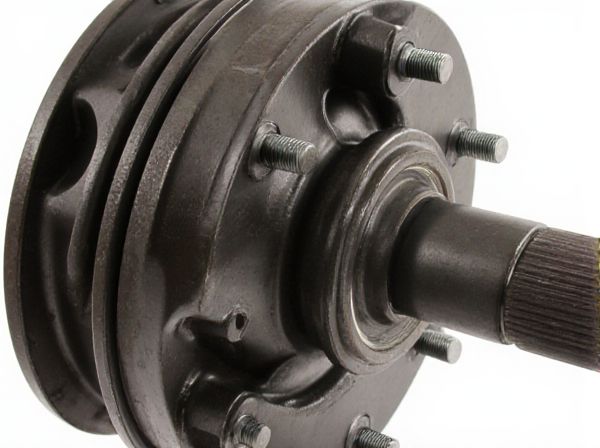
Photo illustration: Independent vs Solid Axle
Independent suspension systems allow each wheel to move independently, improving ride comfort and handling on uneven terrain. Solid axles connect wheels on the same axle, providing increased strength and durability, especially useful for heavy loads and off-road conditions. Choosing the right system depends on your vehicle's intended use and the balance you seek between performance and robustness.
Table of Comparison
| Feature | Independent Differential | Solid Axle Differential |
|---|---|---|
| Design | Each wheel moves independently | Wheels connected by a single axle |
| Ride Comfort | Better, absorbs road irregularities | Stiffer ride, transmits shocks to both wheels |
| Handling | Improved cornering and stability | Less precise, can cause understeer |
| Durability | Less robust, suited for regular roads | Highly durable, ideal for off-road and heavy loads |
| Weight | Lighter, enhances fuel efficiency | Heavier, impacts fuel economy negatively |
| Cost | Higher manufacturing and repair cost | Lower cost, simpler construction |
| Common Usage | Passenger cars, sports cars | Trucks, SUVs, off-road vehicles |
Introduction to Axle Types
Independent suspension systems allow each wheel to move vertically without affecting the opposite wheel, enhancing ride comfort and handling. Solid axles, also known as live axles, connect both wheels with a rigid beam, providing durability and strength for heavy loads and off-road conditions. Understanding these axle types is crucial for selecting the right suspension system based on vehicle performance requirements and terrain challenges.
What is an Independent Axle?
An independent axle allows each wheel to move vertically and react to road conditions independently without affecting the opposite wheel, enhancing ride comfort and handling. This suspension system is commonly used in modern vehicles for improved traction and stability on uneven surfaces. Independent axles reduce unsprung weight, leading to better vehicle dynamics compared to solid axles that connect both wheels rigidly.
What is a Solid Axle?
A solid axle, also known as a live axle, is a rigid beam connecting the wheels on opposite sides of a vehicle, ensuring both wheels move in unison. It is commonly used in trucks and off-road vehicles due to its strength and durability, providing excellent load-bearing capacity and simplicity in design. While it offers robust performance on rough terrains, it typically results in less precise handling and ride comfort compared to independent suspension systems.
Key Differences Between Independent and Solid Axles
Independent axles allow each wheel to move independently, enhancing ride comfort and maintaining better traction on uneven surfaces. Solid axles connect wheels on the same axle, providing greater strength and durability, especially useful for heavy-duty and off-road vehicles. The key difference lies in suspension performance, where independent axles offer improved handling and solid axles deliver superior load-bearing capacity.
Performance Comparison: Handling and Stability
Independent suspension systems offer superior handling and stability due to each wheel's ability to move independently, maintaining better road contact during dynamic driving conditions. Solid axles provide robustness and load-bearing advantage but tend to compromise handling by causing both wheels on an axle to react together, leading to reduced traction and stability on uneven surfaces. Performance-focused vehicles prioritize independent suspension for enhanced cornering precision and improved ride comfort, while solid axles remain common in off-road and heavy-duty applications where durability outweighs handling finesse.
Off-Road Capability: Which Axle Reigns Supreme?
Independent suspension offers superior off-road capability by allowing each wheel to move independently, maintaining better contact with uneven terrain and improving traction on rocks and steep inclines. Solid axles excel in durability and articulation, providing strength for heavy-duty off-road challenges and predictable performance in deep mud or sand. For extreme rock crawling or trail conditions, solid axles often reign supreme due to their robustness and consistent ground clearance beneath the differential.
Ride Comfort and Suspension Dynamics
Independent suspension systems offer superior ride comfort by allowing each wheel to move independently, effectively absorbing road irregularities and reducing vibrations transmitted to the cabin. Solid axles, with their rigid connection between wheels, tend to provide a harsher ride due to increased unsprung weight and limited wheel articulation. Suspension dynamics in independent setups improve handling and stability, especially on uneven terrain, enhancing overall driving experience compared to the simpler, more robust solid axle design.
Durability and Maintenance Considerations
Independent suspensions offer superior ride comfort but require more frequent maintenance due to complex components like CV joints and multiple linkages. Solid axles are known for exceptional durability and simpler design, making them easier and cheaper to maintain, especially in off-road or heavy-duty applications. Maintenance costs for solid axles are generally lower, while independent suspensions may incur higher repair expenses over time due to increased wear and tear.
Applications: Where Each Axle Excels
Independent suspension excels in passenger cars and SUVs by providing superior ride comfort, enhanced handling, and better traction on uneven terrain, making it ideal for on-road and light off-road conditions. Solid axles are preferred in heavy-duty trucks, off-road vehicles, and utility vehicles due to their durability, load-bearing capacity, and ability to maintain ground clearance under heavy loads or rough terrain. Off-road enthusiasts often choose solid axles for extreme environments, while independent suspension suits performance and everyday driving with improved ride quality.
Choosing the Right Axle: Factors to Consider
Choosing the right axle involves evaluating ride comfort, off-road capability, and load capacity, where independent axles provide superior articulation and smoother handling, particularly on uneven terrain. Solid axles offer increased durability and load-bearing strength, making them ideal for heavy-duty applications and rugged conditions. Consider vehicle usage, terrain type, and maintenance preferences to ensure optimal axle performance and longevity.
 caratoz.com
caratoz.com